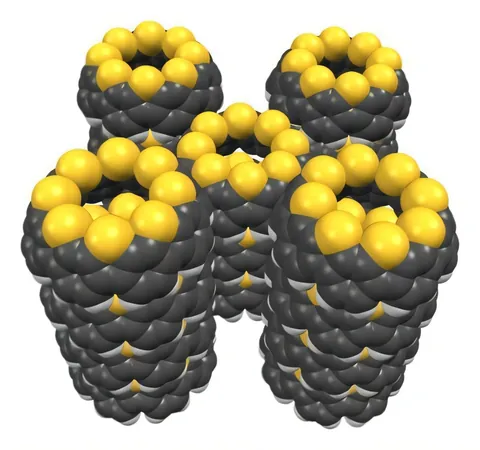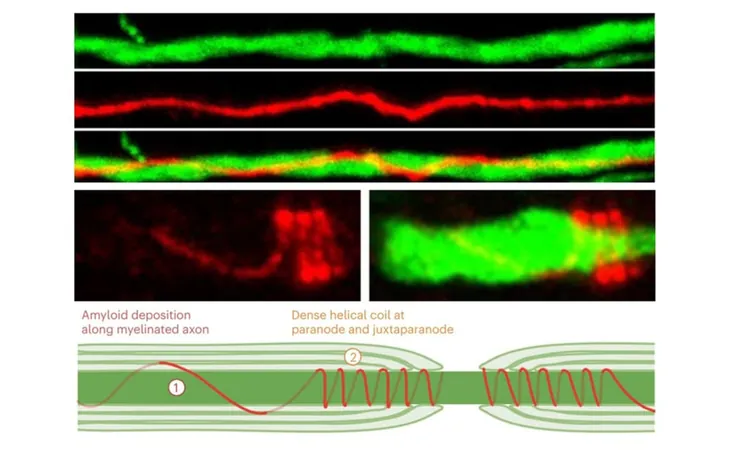
Revolutionary Sulfur-Capped Carbon Nanobelts Set to Transform Technology
2025-05-09
Author: Wei Ling
Breakthrough in Carbon Nanobelt Engineering
In an exciting new development, chemists at RIKEN have unveiled a groundbreaking method for creating carbon nanobelts infused with sulfur-containing functional groups, detailed in their latest study published in Nature Communications. This innovative material is poised to play a crucial role in the evolution of next-generation optoelectronic devices.
The Fascination with Carbon Nanotubes
Since their inception in 1991, carbon nanotubes, which are ultra-thin hollow cylinders composed solely of carbon atoms, have captivated scientists and engineers alike. They have found applications in diverse fields, ranging from electronics to healthcare, inspiring endless research and innovation.
From Concept to Creation: The Rise of Carbon Nanobelts
Carbon nanobelts, essentially slices of carbon nanotubes, offer exciting opportunities for use in advanced electronic and optoelectronic applications. While attempts to synthesize these nanobelts date back to the 1950s, it wasn't until 2017 that a team led by Kenichiro Itami at RIKEN successfully achieved this feat. This pivotal moment ignited a wave of research enthusiasm, with scientists around the globe eager to explore and synthesize various forms of these intriguing structures.
Thiophene Fusion: A Game-Changing Discovery
In their quest to innovate further, Itami's team has ingeniously fused carbon nanobelts with thiophene, a unique compound comprising one sulfur atom and four carbon atoms. This fusion introduces a wealth of functional properties, particularly in semiconducting and fluorescence realms.
Surprising Simplicity in Synthesis
The creation of this new thiophene-fused molecule turned out to be astonishingly straightforward. "It's remarkably simple—a single-shot reaction," exclaimed Itami, delighting in the unexpected ease of the process. The idea was proposed by Hiroki Shudo, the study's lead author, who was inspired by previous research.
Unexpected Alignments on Metal Surfaces
An intriguing aspect of this research was the alignment behavior of the nanobelts: they oriented with their sulfur sides up on copper surfaces but reversed that orientation on gold surfaces. "This discovery has taken us by surprise, and we're now delving into the reasons behind this phenomenon," noted Itami.
Potential Applications Beyond Imagination
These thiophene-fused carbon nanobelts are not merely a scientific novelty; they hold promise for practical applications in optoelectronic devices and polar materials. Excitement surrounding this discovery is already rippling through the research community, with teams from around the world eager to collaborate and integrate these nanobelts into their technologies.
A Future of Collaboration and Innovation
As the RIKEN team shares their findings and synthesizes samples for other research groups, a new era of international collaboration in carbon nanobelt research is on the horizon. The successful synthesis strategy could pave the way for exploring a diverse array of carbon nanobelt variants, signalling exciting possibilities in material science.



 Brasil (PT)
Brasil (PT)
 Canada (EN)
Canada (EN)
 Chile (ES)
Chile (ES)
 Česko (CS)
Česko (CS)
 대한민국 (KO)
대한민국 (KO)
 España (ES)
España (ES)
 France (FR)
France (FR)
 Hong Kong (EN)
Hong Kong (EN)
 Italia (IT)
Italia (IT)
 日本 (JA)
日本 (JA)
 Magyarország (HU)
Magyarország (HU)
 Norge (NO)
Norge (NO)
 Polska (PL)
Polska (PL)
 Schweiz (DE)
Schweiz (DE)
 Singapore (EN)
Singapore (EN)
 Sverige (SV)
Sverige (SV)
 Suomi (FI)
Suomi (FI)
 Türkiye (TR)
Türkiye (TR)
 الإمارات العربية المتحدة (AR)
الإمارات العربية المتحدة (AR)